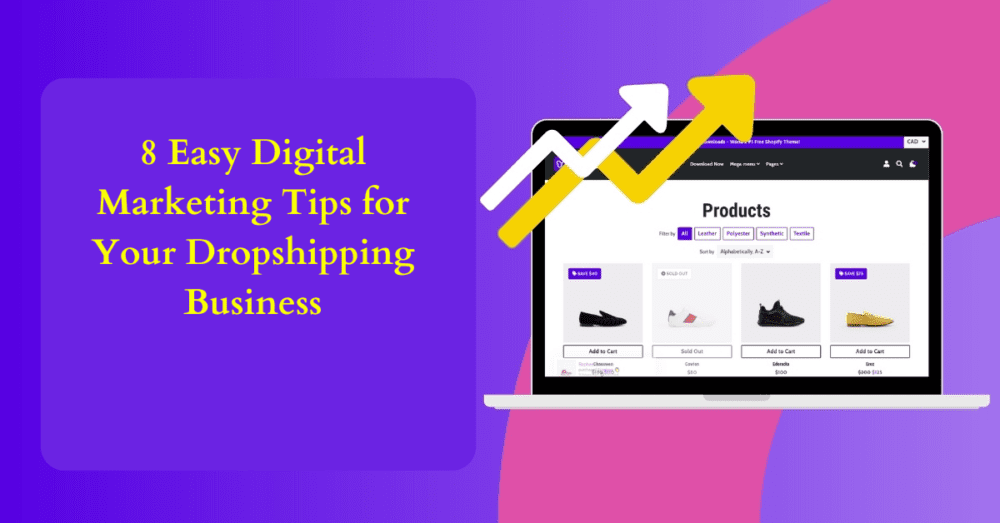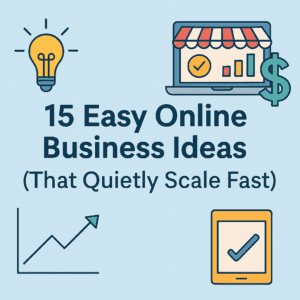Dropshipping is an incredible way to start a business with low upfront costs, no inventory headaches, and the flexibility to sell a variety of products. The global dropshipping market is projected to reach $591.77 billion by 2027, growing at a CAGR of 26.7%.
However, as you grow your dropshipping business, you begin to realize that it’s not all smooth sailing. The ease of entry means it’s a crowded space, making marketing your dropshipping business effectively a critical factor in standing out.
Many dropshipping businesses face the same challenges. According to a study by SaleHoo, 62% of online retailers struggle with marketing and advertising. This can make you frustrated and disappointed sometimes, especially when you’ve invested time and resources into your business.
So, what’s the solution? How can you effectively market your dropshipping business and drive sales in a crowded market?
The answer lies in developing a solid marketing strategy that’s tailored to your business. This guide will walk you through actionable strategies, tools, and techniques that can help you capture attention, drive traffic, and convert visitors into loyal customers.

8-Step Guide to Marketing Your Dropshipping Business
Grow your sales online with our comprehensive guide to marketing your dropshipping business, covering strategies from branding to social media advertising.
1. Define Your Niche and Know Your Audience
The foundation of a successful dropshipping business lies in choosing the right Niche and deeply understanding your target audience. A niche isn’t just a product category; it’s a specific, well-defined area with passionate buyers. For example, let’s say you own an online store, “PetPalace,” a drop shipping business that specializes in eco-friendly pet accessories. Here is a guide on how to define your Niche properly and understand your target audience.
How to Identify Your Niche
Identifying how profitable your preferred Niche is requires research and validation. Here’s how you can do it:
A. Research Market Trends: Use tools like Google Trends, AliExpress insights, and niche discovery platforms like Nichescraper or Trend Hunter to identify trending products.
The fastest way to get this information about your own Niche is to use Google Trends to compare the popularity of different keywords.
Let’s say you’re considering starting a dropshipping business for phone cases or laptop sleeves.
A quick Google Trends analysis shows that phone cases are more popular than laptop sleeves, with a significant spike in searches during the holiday season.
B. Validate Demand: Next, you need to validate the demand for your product niche by checking competition on platforms like Amazon and Shopify stores.
According to a study by Jungle Scout, 70% of Amazon sellers earn up to $25,000 per month, indicating a profitable market.
So, to validate demand, you can use tools like AMZScout or Helium 10 to analyze Amazon sales data and trends.
Let’s say you’re considering selling yoga mats. A quick analysis shows that yoga mats are a top-selling product on Amazon, with over 1,000 reviews and a 4.5-star rating.
C. Assess Profitability: It is essential that you calculate margins after factoring in shipping costs, advertising expenses, and wholesale pricing.
For instance, if the eco-friendly pet toys are sourced for $5 and are sold for $15, this could be a 66% profit margin after advertising.
To assess profitability, you can use a profit margin calculator or create a spreadsheet to track your costs and revenue.
Let’s say you’re considering selling phone cases. You source phone cases for $10 and sell them for $25.
After factoring in shipping costs and advertising expenses, you calculate a profit margin of 40%.
How to Understand Your Ideal Customer
Now, you have to create a detailed buyer persona by answering the following questions. I would use our pet store example as a reference.
- Who are they (age, location, gender)? A pet store’s ideal customer may be a 25-45-year-old person who lives in urban areas and is passionate about sustainability and animal welfare.
- What problems do they face, and how does your product solve them? The ideal customer is probably concerned about the environmental impact of traditional pet products and is looking for eco-friendly alternatives. PetPalace’s products would solve this problem by offering sustainable and biodegradable pet accessories.
- Where do they spend their time online? (Instagram, TikTok, Pinterest?) Our ideal customers are active on Instagram and Facebook, where they follow eco-friendly and animal welfare organizations.
You can now consider the same for your business and can create targeted marketing campaigns that resonate with your audience and drive sales for your drop shipping business.
2. Build a Conversion-Optimized Online Store
You need to understand that your website is your storefront. If it doesn’t look professional or loads slowly, potential customers will leave without a second thought. Here’s how to optimize your site to shine:
Some Design Tips for Dropshipping Websites
Creating a captivating online store is essential to drive sales. Here are some basic design tips for dropshipping websites that will elevate your brand, enhance user experience, and boost conversions.
A. Use a Professional Theme: Choose a customizable theme from Shopify, which is optimized for eCommerce. This helps to create a professional-looking website without needing extensive coding knowledge. The ease of navigation is essential, too.
Your website should feature a clean and modern design, with clear categories and product pages. This makes it easy for customers to find what they’re looking for.
B. Optimize for Speed: Slow-loading websites can lead to high bounce rates and lost sales. To optimize your website’s speed, you have to compress images, use lightweight plugins, and consider a Content Delivery Network (CDN).
A 1-second delay in page load time can result in a 7% reduction in conversions.
Your website should load in under 3 seconds, ensuring that customers can quickly and easily browse products.
C. Implement Trust Signals: Trust is crucial for online sales. To build credibility, you can display customer reviews, secure payment badges, and clear return policies on your website.
According to a study by Shopify, 79% of consumers trust online reviews as much as personal recommendations.
If possible, your website should feature a prominent “Trustpilot” badge, showcasing its excellent customer reviews. This helps build trust with potential customers.
Create Product Pages That Sell
Your product pages are crucial for converting browsers into buyers. Here’s how to optimize Your product pages:
A. High-quality images and videos: You have to use high-quality images and videos to showcase products from different angles. This helps customers get a better sense of the product.
63% of consumers are more likely to return to a website with high-quality images.
So ensure product pages feature high-quality images of your products, with zoom functionality and 360-degree views.
B. Engaging, benefit-focused descriptions: Ensure to write engaging, benefit-focused product descriptions that highlight the unique features and benefits of each product. HubSpot released a study that shows when product descriptions focus on benefits rather than features, it can increase conversions by up to 20%.
Your product descriptions should emphasize the great materials used in each product, highlighting the benefits for your customers and how easily it solves their problems.
C. Clear CTAs (e.g., “Buy Now,” “Limited Stock Available!” ): Uses clear and prominent calls-to-action (CTAs) on each product page, encouraging customers to make a purchase. According to a study by Unbounce, CTAs that create a sense of urgency can increase conversions by up to 15%. Using these CTA’s on your product pages also helps to create a sense of urgency.
3. Leverage Social Media for Brand Awareness
Social media is your playground for building awareness and engagement. Dropshipping businesses thrive on platforms like Instagram, TikTok, and Facebook. Here’s how to leverage social media to grow your dropshipping business:
Instagram Strategies For Your Dropshipping Business
Instagram is one of dropshippers’ favorite platforms for showcasing their products. Here’s how to use Instagram to drive sales:
A. Shoppable Posts: Enable Instagram Shopping to let users purchase directly from your posts.
75% of users take action after seeing a brand’s post, such as visiting their website or making a purchase. Customers can simply tap on your product to purchase it.
B. Reels and Stories: Share quick, engaging videos showcasing products in use. You can use Instagram Reels to create 60-second videos that demonstrate the benefits of your products as well.
People are 52% more likely to share video content than any other type of content.
C. Influencer Collaborations: You can partner with micro-influencers in your Niche to tap into their loyal audiences. Choose influencers who align with your values and target audience.
Micro-influencers have a 22% higher conversion rate compared to larger influencers.
TikTok Advertising For Your Dropshipping Business
TikTok is also a great platform for a dropshipping businesss owner. Here’s how to use TikTok to drive sales:
A. Product Demos: Create short, engaging videos that demonstrate how your products solve a problem.
63% of users prefer watching videos that demonstrate a product’s features and benefits.
B. Behind-the-Scenes Content: Share behind-the-scenes content that showcases your journey, from sourcing products to shipping.
44% of consumers feel more connected to a brand when they see behind-the-scenes content.
In the Pet store example, your TikTok feed could feature videos from your trips to trade shows, where you source new products for your store.
C. Hashtag Challenges: Try to create viral trends around your products by launching hashtag challenges. Hashtag challenges can increase engagement by up to 50%.
Facebook Groups
Try to participate in niche-specific Facebook groups to build awareness and drive sales for your products. Here’s how to use Facebook groups:
A. Share Value: Share valuable content to establish yourself as an authority in your Niche. According to a study by Facebook, 67% of users join groups to connect with others who share similar interests.
For example, in the Pet store example, you can share posts on Facebook groups that feature tips on how to reduce waste when caring for pets.
B. Subtle Mentions: Always subtly mention products in these posts without coming across as too salesy. subtle mentions of products are more effective than overt sales pitches in this groups.
For our pet store example, your post on this group’s Facebook group features a post that mentions the benefits of using eco-friendly pet toys, with a subtle link to your website.
4. Take advantage of the Power of Paid Advertising
Organic reach is valuable but limited. Paid ads can amplify your reach and drive targeted traffic. To amplify your reach and drive targeted traffic, you can use paid advertising. Here’s how to take advantage of the power of paid advertising:
Using Facebook and Instagram Ads for Your Dropshipping Business
Use Facebook and Instagram ads to target specific audiences and drive sales. Here’s how to use these platforms:
A. Retargeting Ads: Show your ads to people who visited your website but didn’t purchase. This strategy mostly increases your conversion rate.
Retargeting your ads can increase conversion rates by up to 147%.
B. Lookalike Audiences: You can use your existing customer data to find similar users on Facebook and Instagram.
Lookalike audiences can increase your conversions by up to 50%.
C. Carousel Ads: Use carousel ads to highlight multiple products in a single ad.
Carousel ads can increase your CTR by up to 30%.
For our Petstore example, you can use Instagram carousel ads to feature a series of images showcasing different eco-friendly pet toys, with a clear CTA to encourage users to visit the website.
Using Google Shopping Ads for Your Dropshipping Business
You can also use Google Shopping ads to target bottom-of-funnel customers who are ready to buy. Here’s how to optimize your Google Shopping ads:
A. Optimize Product Titles: Optimize your product titles with high-intent keywords to increase visibility and drive sales. For our Pet store example their Google Shopping product titles should feature keywords like “eco-friendly pet toys” and “sustainable pet accessories” to attract high-intent customers.
B. Provide Accurate Pricing and Stock Information: Ensure that your product listings feature accurate pricing and stock information to increase trust and drive sales.
Accurate pricing and stock information can increase conversions for your business by up to 15%.
C. Use Professional Images: Use professional images for your product listings to increase visibility and drive sales.
High-quality images can increase your conversions by up to 10%.
Using TikTok Ads for Your Dropshipping Business
You can use TikTok ads to target a younger audience and drive sales to your business. Here’s how to use TikTok ads:
A. In-Feed Ads: Use in-feed ads to showcase your products in a native format.
In-feed ads can increase brand awareness by up to 20%.
B. Branded Content: Partner with popular TikTok creators to showcase your products in a branded content format. For our pet store example, you can partner with a popular TikTok creator who showcases eco-friendly pet toys in a fun and engaging video.
5. Create Content That Converts
Content marketing is essential for building trust and organic traffic in your business, even though it may seem like a long game. Here’s how she creates content that converts:
Your Dropshipping Business Needs a Blog
Start a blog on your website to write articles around your Niche. According to a study by HubSpot, businesses that blog regularly see a 55% increase in website traffic. Here’s how to use blogging to drive sales:
A. “Top 10 [Product Type] for 2024”: For example, on the pet store website, you can write a blog post that showcases the top 10 eco-friendly pet toys for the current year. This post would attract organic traffic and establish your brand as an authority in your Niche.
B. “How to Use [Your Product] for Maximum Benefits”: Write blog posts that provide tips on how to use the products you sell for maximum benefits. This post would establish your site as a trusted authority in the Niche and drive sales.
70% of your customers would prefer to learn about your products through articles rather than ads.
SEO Basics for Dropshipping
SEO is essential for ensuring that dropshipping websites appear in search results. 53% of your website traffic would most likely come from organic search. Here’s how to optimize your website for SEO:
A. Use Tools Like Ubersuggest or Ahrefs: Use tools like Ubersuggest or Ahrefs to identify keywords that attract organic traffic.
B. Optimize Meta Titles, Descriptions, and Product Pages: Optimize your website’s meta titles, descriptions, and product pages to ensure that they appear in search results.
Optimized meta titles and descriptions can increase click-through rates by up to 20%.
C. Get Backlinks: Get backlinks by reaching out to blogs and forums in your Niche. For our Pet store Example, you can reach out to pet bloggers and offer them free eco-friendly pet toys in exchange for reviews and backlinks.
Email Marketing For Your Dropshipping Business
Your email marketing strategy is essential for nurturing leads and driving sales. Here’s how to use email marketing to grow your online dropshipping business:
A. Capture Emails: Capture emails with pop-ups offering discounts or freebies. You can use pop-ups to increase your email conversions by up to 60%.
For example, your website may feature a pop-up that offers a 10% discount on the first purchase in exchange for an email address. This pop-up would increase your email conversions by a high percentage.
B. Nurture Your List: Nurture your email list with regular newsletters that feature product updates, exclusive offers, and cart abandonment reminders. Email newsletters can increase sales by up to 20%.
6. Build Trust and Foster Customer Loyalty
Repeat customers are the lifeblood of any business. Dropshipping faces unique challenges in trust-building due to long shipping times and third-party fulfillment. So, building trust and fostering customer loyalty is crucial for driving repeat business and growth. Here’s how to build trust and loyalty you’re your customers:
Clear Communication
Clear communication is key to building trust with your customers. Here’s how to communicate effectively:
A. Shipping Transparency: Set realistic delivery expectations on your website to avoid disappointing customers. Your website may feature a shipping policy page that clearly outlines delivery times and expectations.
B. Responsive Support: Offer 24/7 live chat or quick email responses to resolve customer queries.
90% of customers expect an immediate response to their queries.
Loyalty Programs
Loyalty programs are great for rewarding customers and driving repeat business. Here’s how you can reward your customers:
A. Offer Discounts for Referrals: You can offer a slight discount on the next purchase for customers who refer friends to your online store. Referral programs can increase your sales by up to 20% when done properly.
B. Create a Points-Based System: Depending on your profit margin, you can create a points-based system that rewards customers for purchases. Customers can redeem points for discounts or free products.
Engage Post-Sale
Engaging with customers post-sale can build more loyalty and help drive repeat business. Here’s a strategy to engage with your customers:
A. Send Personalized Thank-You Emails: Sends personalized thank-you emails to customers after their purchase.
B. Request Reviews or Testimonials: Request for reviews or testimonials from customers after their purchase.
85% of customers trust online reviews as much as personal recommendations.
C. Share Tips on Using Their Purchased Products: Share tips on using your products in follow-up emails.
Educational content can increase customer loyalty by up to 20%.
For our pet store example, your email system may send follow-up emails with tips on using eco-friendly pet toys. These emails may feature images, videos, and step-by-step instructions.
7. Experiment and Optimize Your Digital Marketing Strategies
Marketing is not a one-size-fits-all strategy. You have to continuously test and refine your approach. Here are some tips on how to experiment and optimize:
Track Your Online Store’s Key Metrics
Monitor key metrics to measure the success of your marketing efforts. Here’s what to track:
A. Conversion Rates: Tracks conversion rates to see how many website visitors are completing a purchase.
B. Customer Acquisition Cost (CAC): Tracks CAC to see how much it costs to acquire a new customer.
C. Lifetime Value (LTV): Tracks LTV to see how much revenue each customer generates over their lifetime.
Perform A/B Testing on Your Different Marketing Efforts
Use A/B testing to experiment with different marketing strategies and optimize results. Here’s what to test:
A. Ad Copy Variations: Test different ad copy variations to see which ones perform better.
A/B testing ad copy can increase conversions by up to 25%.
For the Pet Store example, your Facebook ads may feature different ad copy variations, such as “Get 10% off your first order!” versus “Free shipping on all orders over $50!”. Uses A/B testing to determine which ad copy variation performs better.
B. Landing Page Designs: Test different landing page designs to see which ones convert better.
A/B testing landing pages can increase conversions by up to 30%.
For example, your website may feature different landing page designs, such as a simple design with a clear call-to-action (CTA) versus a more complex design with multiple CTAs. Use A/B testing to determine which landing page design performs better.
C. Email Subject Lines: Tests different email subject lines to see which ones perform better. For the Petstore example, your email newsletters may feature different subject lines, such as “New Arrivals: Eco-Friendly Pet Toys!” versus “Get 10% off your next order!”. Use A/B testing to determine which subject line performs better.
Analyze Competitors
Use tools like SEMrush or SimilarWeb to analyze your competitors and see what’s working for them. Here’s what she analyzes:
A. Keyword Strategy: Analyze your competitors’ keyword strategy to see which keywords they’re targeting.
B. Content Strategy: Analyze your competitors’ content strategy to see what types of content they’re creating.
8. Explore Emerging Trends For Marketing Online Stores
Staying ahead of the curve and embracing new trends is crucial for success in the competitive world of dropshipping. Here are some emerging trends to explore:
AI Tools for Personalized Marketing
There is a huge potential in the use of AI tools for personalized marketing. You can use AI-powered tools to analyze customer data and create personalized product recommendations.
62% of customers expect personalized experiences from brands.
Voice Search Optimization
Voice search is becoming increasingly popular, so you want to ensure that your business’s website is optimized for voice search. Use tools like Google’s Voice Search Simulator to test your website’s voice search functionality. A study by ComScore shows that 50% of all searches will be voice searches by 2025.
Social Commerce on Platforms like Threads or Pinterest
There’s also a huge potential in social commerce on platforms like Threads or Pinterest. Use these platforms to showcase the products you are dropshipping and connect with customers.
Final Thoughts
Congratulations on making it the end of our comprehensive guide to digital marketing for dropshipping businesses. By now, you should have a clear understanding of how to overcome the common pain points that many dropshipping entrepreneurs face.
Remember that marketing a dropshipping business requires creativity, consistency, and a willingness to adapt. By combining your niche expertise, strategic content, and smart advertising, you’ll be well on your way to building a thriving dropshipping brand that attracts and retains loyal customers.
If you found this article helpful, please share it with your fellow entrepreneurs on social media! Your share could help someone else overcome their marketing challenges and achieve success.



